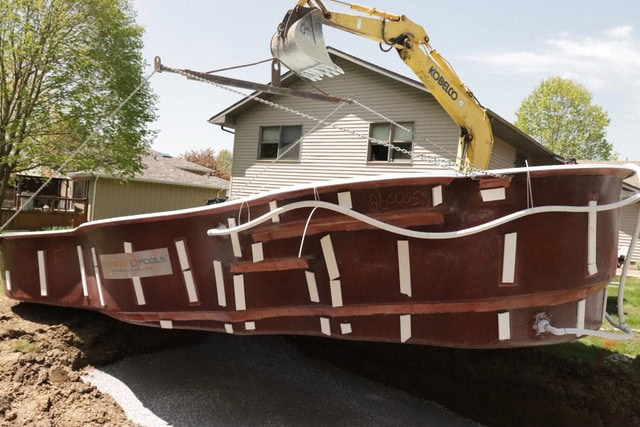Three Unknown Facts About Fiberglass Inground Pool Construction

When thinking about inground pool construction, one may picture giant heavy machinery excavating, workers building the pool walls in the excavated hole, and more. Such is the case for a lot of inground pool construction projects, but a fiberglass pool installation looks a little different.
Royal Pools G2 Landscaping has been in the business of installing inground pools for over 25 years now. The process of fiberglass inground pool construction is shockingly streamlined compared to concrete and vinyl liner pools.
You might be wondering what makes fiberglass construction different. If you’re unfamiliar with fiberglass pools and are curious, let’s talk about a few fiberglass inground pool construction facts you may not know. Without further ado, let’s dive in!
Fiberglass Pools Are Constructed Off-Site and Then Transported to Your Backyard

Unlike concrete and vinyl liner pools, which are built almost entirely in your backyard, fiberglass pools are manufactured off-site in fiberglass manufacturing facilities. Each pool shell is molded from a durable fiberglass mold and finished with a gel coat that provides a smooth, non-porous surface.
Once the shell is complete, your fiberglass pool is transported to your home using a flatbed trailer and carefully lowered with a crane into a hole excavated by your swimming pool contractor.
The pool shell is thoroughly quality-tested before it ever reaches your property, so homeowners can expect exceptional durability and consistency. Should a fiberglass pool fail soon after the installation, it is usually the result of poor installation.
Fiberglass Pools Are the Quickest to Install at 3 – 6 Weeks
We get it, purchasing an inground pool is very exciting. Unfortunately, they cannot magically appear complete in your backyard. They will take multiple weeks. If you’re overly eager and looking for the quickest installation time, fiberglass pools lead the pack.
Because the shell is pre-built and delivered to your home ready to install, the entire inground pool construction process generally takes three to six weeks from start to finish. This may vary depending on your swimming pool contractor, the fiberglass pool manufacturer, location, weather, etc.
This timeline includes excavation, setting the pool shell, plumbing, backfilling, pouring the patio, as well as any landscaping final touches. By contrast, vinyl liner pools typically take at least 4-5 weeks to install, whereas concrete pools can take 6-10 weeks or even upward to three months, depending on the size of the pool.
If Installed And Maintained Properly, the Water Put In Your Fiberglass Pool Should Never Be Removed
Perhaps the biggest advantage of fiberglass pools is their low-maintenance design. The smooth, non-porous gel coat prevents algae from growing on the surface, significantly reducing the need for harsh chemicals and draining.
In fact, if installed and maintained correctly, you should never have to completely remove the water from your fiberglass pool. Draining a fiberglass pool can cause the shell to lift or shift due to hydrostatic pressure from surrounding groundwater. That’s why experienced swimming pool contractors always emphasize proper installation methods, including high-quality backfill materials and reliable ground dewatering systems.
Conclusion
There you have it, folks! We hope these three interesting facts about fiberglass inground pool construction were informative. Maybe they helped you determine if a fiberglass pool is right for you. While fiberglass pools do have their pros and cons, their ease of maintenance and quick installation times are highly attractive to many prospective pool buyers. Whatever way we can help, we love educating pool owners and prospective pool buyers alike.
Do you have more fiberglass pool questions? If so, check out the articles below. For more educational content on all things pools and landscaping, dive into our learning hub at the top of our page. Thank you for reading!
Fiberglass Pool Maintenance: How To Master Your Pool
9 Best Fiberglass Pool Options Under $90K
Fiberglass Pool Problems: Can They Crack?
Written by Logan Edgemon
